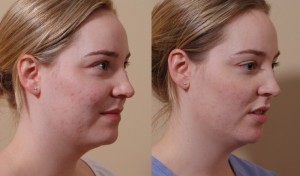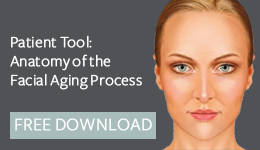Advancements in Laser Skin Resurfacing

Luckily, there are many modern aesthetic treatments available to address the changes aging brings to our face. One of the most effective treatments is laser skin resurfacing. This treatment is generally used for:
- wrinkle reduction
- skin discoloration
- superficial acne scars or other scarring conditions.
Fractionated CO2 laser skin resurfacing is one of the leading breakthroughs in this area. It combines the effectiveness of the older carbon dioxide lasers, with new application techniques to deliver results without the harsh side effects of non-fractionated treatments.
How Does it Work?
The aging process, along with exposure to pollution and sun, actually destroys the collagen that keeps skin wrinkle free and plump. Laser resurfacing uses pulses of energy to treat microscopic areas, vaporizing microscopic columns of tissue. These tiny treated areas are surrounded by untreated skin allowing for faster healing from the surrounding intact areas and fewer complications than with non-fractionated laser treatment. The healing skin induces new collagen production for a rejuvenated effect.
The Procedure
Prior to the treatment, bleaching creams and retinoids may applied beginning about three weeks before the procedure. Anti-viral medications are also used before and after the treatment. Be sure to tell your doctor if you have a history of cold sores.
Depending upon the size of the treatment area, patients may need a “twilight” anesthesia or injections of local anesthetic. The skin is cooled during the laser application as the physician moves the device over the treatment area. Most patients report only minimal discomfort during the procedure which is performed in an outpatient setting.
What to Expect After Surgery
After the procedure, a non-petroleum jelly will be applied to the skin for a few days while healing occurs. The time for recovery after the procedure depends on the intensity and size of the treated area, with a full face treatment requiring longer healing time that a smaller region of treated skin. The redness of the skin surface will gradually decrease over days to weeks and anti-inflammatory medications may be used to reduce swelling or redness. Platelet rich plasma (PRP) can be introduced into the healing field to speed skin regeneration. As it heals, the pink skin can be covered up with make-up after the treated areas have healed over with new skin. Since new skin is more sensitive to sun damage, patients should wear sunscreen to protect their new skin.
Who May Not Be a Candidate for Fractional Laser
Individuals who have a history of abnormal scarring may not heal well after resurfacing. Those with skin conditions or immune disorders that impede healing may have a more difficult time recovering. Infections also prevent smooth recovery and are a contraindication to resurfacing treatment as is the use of isotretinoin for acne treatment within the previous 6 to 12 months.
Benefits of Fractionated CO2 Laser Procedure
Fractional CO2 laser treatments allow for faster recovery times than treatments with non-fractionated laser. This procedure also lessens the possibility of potential complications that can include delayed hypo-pigmentation and scarring.
Patients may need several treatments to achieve the desired results; however, because the fractional CO2 laser resurfacing procedure does not entail the long healing time associated with older resurfacing methods, it is ideal for patients who cannot take extended periods of time off from work.
Other Options for Skin Rejuvenation
If you want a smoother and more youthful look, your choices include micro-needling, chemical peel and dermabrasion as well as laser resurfacing. All these techniques involve injury to the top skin layers, stimulation of collagen formation and regrowth of new skin. These methods may be used individually or in combination to smooth skin, flatten scars, and even skin tone. So if you are ready for a revitalized, fresher look, consult with an experienced cosmetic surgeon to review all your possibilities.

I had such a positive experience here with Dr. Z and his staff. From the initial consultation to my post-surgery appts. I couldn't have asked for a better experience. All my questions/concerns were addressed, the surgery itself went really well (and I am so happy with my results, seriously life changing), my recovery went smoothly and Dr. Z gave me his personal cell # so I could reach out if I had any worries during my recovery. Dr. Z and his staff truly care about their patients and go above and beyond to deliver the best results! I highly recommend coming here if you need any aesthetic surgery, you won't be disappointed.